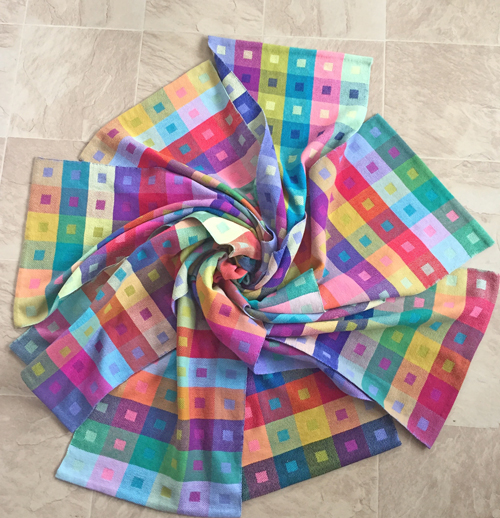Warning: weaverly post
I have lots of things to say, but this post is to follow up on the last about my colorful Safe At Home towels. I’ve gotten lots of questions about them, so here goes with some answers.
This is an 8 harness twill blocks weave structure: 3/1 twill and 1/3 twill. I’d seen a photo of Catherine Marchant’s work on Facebook. I loved the way it looked and sat down with Fiberworks weaving software to figure out how to achieve it. It took me some time, but I got there.
Although I know others recommend doing your treadle tie up so that you are alternating use of right and left legs, I don’t do this. It’s much easier for my brain to do a more typical tie up, with treadles 1-8 or 10 in order from left to right. This time I modified that. I tied the treadles so that my pressing order was 4-5-3-6 for one portion of twill and 1-8-2-7 for the other portion. This was for 2 reasons: the 4-5-3-6 section had many more repeats and I was lifting 6 shafts with each of those treadles. Sure didn’t want to do all that with one leg, and one that had to stretch to treadle 1 every time. (Yes, I have short legs.)
I used 6 colors in the warp. Each towel has 11 weft-wise stripes. For 7 of the 8 towels, each weft stripe was a different color. On 1 towel I tried simply alternating a light and dark weft, but I didn’t like it as well.
This was the second warp in a row that I lost count of the warps while I was winding them. Of course I didn’t know that until I was threading the loom. I was 10 threads short of one color and didn’t have any choice but to hang 10 threads off the back of the loom. I don’t like hanging so many and was quite concerned about tension issues, but it all worked out fine.
Someplace on Facebook I recently saw a new weaver asking questions about hanging threads, and one of the answers was to tie a shoelace or length of heavy yarn onto the film canister (or whatever else you use). That shoelace has to be long enough to touch the ground. It’s job is to keep the film canister from spinning and untwisting the plied yarn. Hmmmm, I thought. Seems too simple.
NOT!!! It works BEAUTIFULLY! I’ve always had a problem with the hanging yarn untwisting, and this solves it so easily. I happen to have a few dozen old corset laces (no, I never wore a corset), so they’re longer than a standard shoelace. Although I left so many other things behind when I moved almost 5 years ago, I brought these, and now I’m very glad I did.
Honestly, if there were other questions I can’t remember them right now. Ask in a comment an I’ll either answer you or modify the post.



These towels make me smile! I may have to put on a warp and make some. Thank you for sharing the details.
Thanks, Liz. These are happy towels indeed. I will have to weave more.
Peg,
Beautiful towels they just make me want to smile. I do a lot of turned twill work. You can weave the draft upside down. That means that you weave most with lifting one shaft and the smaller part of the draft lifting 6. You will see the back of the towel as you work, but it is much less work as you go.
Hah! I realized that when I was on about towel #6, Charlene! Although I don’t mind working upside down, by that point I didn’t want to change the tie up; my legs were used to it. But thanks for commenting – if I hadn’t known this I’d want to.
Thanks so much for sharing this info on the lovely colorful towels. Can you share more about the draft on the natural cotton, too.
That’ll be the topic of my next post, Alma. 🙂